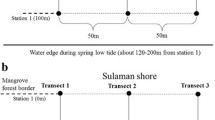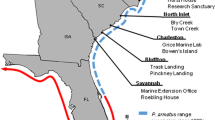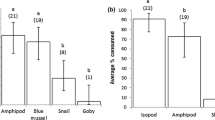Abstract
Estuaries in the Gulf of Maine contain disjunct, isolated populations of a number of invertebrate taxa typically distributed only sound of Cape Cod. These estuarine populations may either be remnants of a southern fauna that were stranded by Quaternary changes in water temperature, or they may have been established more recently via larvae that entered the estuaries from the open ocean. We tested these hypotheses by examining the distribution of sibling species of hydroids that are symbiotic on paguriid hermit crabs. These crab-hydroid species pairs differ greatly in their ability to colonize new areas through the water column. The hermit crabs possess a planktonic larva that can disperse great distances, while the hydroids have a crawling planula larva that is extremely limited in its dispersal capabilities. Consequently, estuarine hermit crab populations that lack their native hydroid symbiont are likely to have originated by larval colonization. Hydroid sibling species were identified on the basis of MDH electromorphs. Species identifications were confirmed through a limited number of test matings with colonies of known species identity. In three out of the four estuaries that we examined, shells inhabited by the southern hermit crab,Pagurus longicarpus, were occupied only by the local northern hydroid,Hydractinia polyclina. This pattern is consistent with a more recent establishment of the hermit crab populations through larval dispersal or transport. However, in Casco Bay, shells inhabited byP. longicarpus were occupied by a mixture of the northern hydroid,H. polyclina, and the southern hydroid,H. symbiolongicarpus, that is associated withP. longicarpus throughout the southern part of its range. Thus, theP. longicarpus population in Casco Bay may either be a relict of a former, more broadly distributed population of this crab in the Gulf of Maine, or if recently established, is likely to have originated by the introduction of adult crabs with hydroid-covered shells.
Similar content being viewed by others
Literature Cited
Ballard, W. W. 1942. The mechanism of synchronous spawning inHydractinia andPennaria.Biological Bulletin (Woods Hole) 82: 329–339.
Barnhardt, W. A., W. R. Gehrels, D. F. Belknap andJ. T. Kelly. 1995. Late Quaternary relative sea-level change in the western Gulf of Maine: Evidence for a migrating glacial forbulge.Geology 23:317–320.
Bousfield, E. L. andD. R. Laubitz. 1972. Station lists and new distributional records of littoral marine invertebrates of the Canadian Atlantic and New England regions.National Museum of Canada, Publications in Biological Oceanography 5:1–51.
Bousfield, E. L. andM. L. H. Thomas. 1975. Postglacial changes in distribution of littoral marine invertebrates of the Canadian Atlantic and New England regions.Proceedings of the Nova Scotian Institute of Science 27:47–60.
Bunting, M. 1894. The origins of sex-cells ofHydractinia andPodocoryne.Journal of Morphology 9:203–236.
Buss, L. W. andP. O. Yund. 1988. A comparison of recent and historical populations of the colonial hydroidHydractinia.Ecology 69:646–654.
Buss, L. W. andP. O. Yund. 1989. A sibling species group ofHydractinia in the northern United States.Journal of the Marine Biological Association of the United Kingdom 69:857–874.
Carlton, J. T. 1989. Man’s role in changing the face of the ocean: Biological invasions and implications for conservation of near-shore environments.Conservation Biology 3:265–273.
Cunningham, C. W., L. W. Buss, andC. Anderson. 1991. Molecular and geologic evidence of shared history between hermit crabs and the symbiotic genusHydractinia.Evolution 45: 1301–1315.
Emery, K. O., A. S. Merrill, andE. R. M. Druffel. 1988. Changed late Quaternary marine environments on Atlantic continental shelf and upper slope.Quaternary Research 30:251–269.
Fairbridge, R. W. 1992. Holocene marine coastal evolution of the United States, p. 9–20.In C. Fletcher and J. Wehmiller (eds.), Quaternary Coasts of the United States: Maine and Lacustrine Systems. Society of Economic Paleontologists and Mineralogists, Special Publication Number 48. Tulsa, Oklahoma.
Folino, N. C. 1989. The dynamics of a nudibranch-hydroid predator-prey association:Cuthona nana andHydractinia echinata. Ph.D. Dissertation, University of New Hampshire, Durham, New Hampshire.
Ganong, W. F. 1890. Southern invertebrates on the shores of Acadia.Transactions of the Royal Society of Canada 4:167–185.
Hussey, A. M., III. 1982 The geology of the Two Lights and Crescent Beach state parks area, Cape Elizabeth, Maine.Maine Geological Survey Department of Conservation Bulletin 26: 1–34.
Ingolfsson, A. 1995. Floating clumps of seaweed around Iceland: Natural microcosms and a means of dispersal for shore fauna.Marine Biology 122:13–21.
Jeffries, H. P. 1962. Succession of twoAcartia species in estuaries.Limnology and Oceanography 7:354–364.
Kelly, J. T., S. M. Dickson, D. F. Belknap, and R. Stuckenrath, Jr. 1992. Sea-level change and late Quaternary sediment accumulation on the southern Maine inner continental shelf, p. 23–34.In C. Fletcher and J. Wehmiller (eds.), Quaternary Coasts of the United States: Maine and Lacustrine Systems. Society of Economic Paleontologists and Mineralogists, Special Publication Number 48. Tulsa, Oklahoma.
Knebel, J. H. andK. M. Scanlon. 1985. Sedimentary framework of Penobscot Bay, Maine.Marine Geology 65:305–324.
Leitz, T. andT. Wagner. 1993. The marine bacteriumAlteromonas espejiana induces metamorphosis of the hydroidHydractinia echinata.Marine Biology 115:173–178.
Lowell, T. V. 1991. Late Wisconsin iceberg-calving rates and ice-sheet mass balance reconstructed from paleo-sea levels, Mount Desert Island, Maine.Geological Society of America Bulletin 85:491–494.
Mayer, L. M., D. W. Townsend, N. R. Pettigrew, T. C. Loder, M. W. Wong, D. Kistner-Morris, A. K. Laursen, A. D. Schoudel, C. Conairis, J. Brown, and C. Newell. 1996. The Kennebec, Sheepscot and Damariscotta river estuaries: Seasonal oceanographic data. University of Maine, Department of Oceanography, Technical Report No. 9601. Orono, Maine.
McAlice, B. J. 1981. On the post-glacial history ofAcartia tonsa (Copepoda: Calanoida) in the Gulf of Maine and the Gulf of St. Lawrence.Marine Biology 64:267–272.
Müller, W. 1969. Auslösung der Metamorphose durch Bakterien bei den Larven vonHydractinia echinata.Zoologische Jahrbücher Abteilung für Anatomie und Ontogenie der Tiere 86:84–95.
Müller, W. A., F. Wieker, andR. Eiben. 1976. Larval adhesion, releasing substance, and metamorphosis, p. 339–346.In G. O. Mackie (ed.), Coelenterate Ecology and Behavior. Plenum Press, New York.
Rebach, S. 1974. Burying behavior in relation to substrate and temperature in the hermit crabPagurus longicarpus.Ecology 55: 195–198.
Richardson, B. J., P. R. Baverstock, andM. Adams. 1986. Allozyme Electrophoresis: A Handbook for Animal Systematics and Population Studies. Academic Press, Orlando, Florida.
Rothlisberg, P. C. andJ. A. Church. 1994. Processes controlling the larval dispersal and postlarval recruitment of penaeid prawns. p. 235–252.In P. W. Sammarco and M. L. Heron (eds.), Coastal and Estuarine Studies. American Geophysical Union, Washington, D.C.
Scheltema, R. S. 1971. The dispersal of the larvae of shallow-water benthic invertebrate species over long distances by ocean curents, p. 7–28.In D. Crisp (ed.), Fourth European Marine Biology Symposium. Cambridge University Press, Cambridge, United Kingdom.
Scheltema, R. S. 1977. Dispersal of marine invertebrate organisms: paleobiogeographic and biostratigraphic implications, p. 73–108.In E. G. Kauffman and J. E. Hazel (eds.), Concepts and Methods of Biostratigraphy. Dowden, Hutchinson and Ross Inc., Stroudsberg, Pennsylvannia.
Schnitker, D. 1974. Postglacial emergence of the Gulf of Maine.Bulletin of the Geological Society of America 85:491–494.
Shanks, A. 1995. Mechanisms of cross-shelf dispersal of larval invertebrates and fish, p. 323–367.In L. McEdward (ed.), Ecology of Marine Invertebrate Larvae. CRC Press, Inc., Boca Raton, Florida.
Walker, S. E. 1992. Criteria for recognizing marine hermit crabs in the fossil record using gastropod shells.Journal of Paleontology 66:535–558.
Weiss, V. M., D. R. Keene, andL. W. Buss. 1985. Biology of hydractiniid hydroids. 4. Ultrastructure of the planula ofHydractinia echinata.Biological Bulletin (Woods Hole) 168:403–418.
Yund, P. O. andH. M. Parker. 1989. Population structure of the colonial hydroidHydractinia sp. nov. C in the Gulf of Maine.Journal of Experimental Marine Biology and Ecology 125: 63–82.
Author information
Authors and Affiliations
Corresponding author
Rights and permissions
About this article
Cite this article
Folino, N.C., Yund, P.O. The distribution of hydroid sibling species on hermit crabs in estuaries in the Gulf of Maine. Estuaries 21, 829–836 (1998). https://doi.org/10.2307/1353284
Received:
Accepted:
Issue Date:
DOI: https://doi.org/10.2307/1353284




